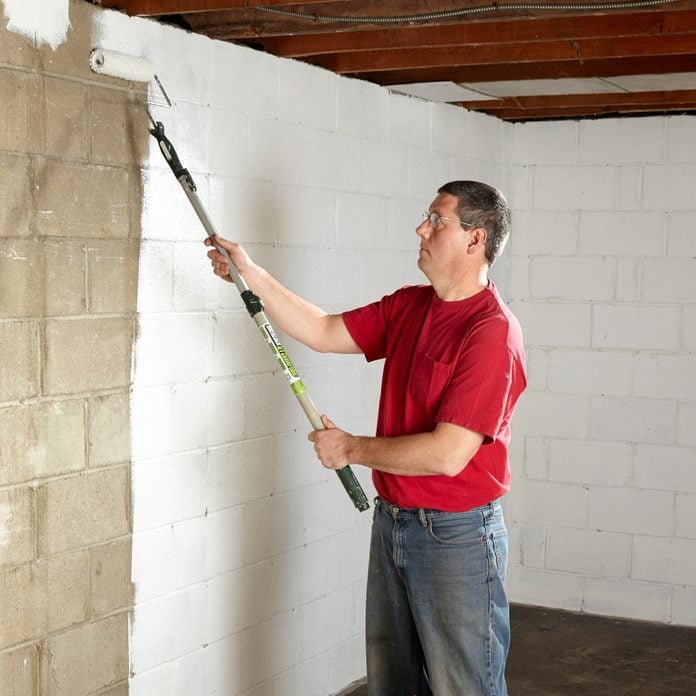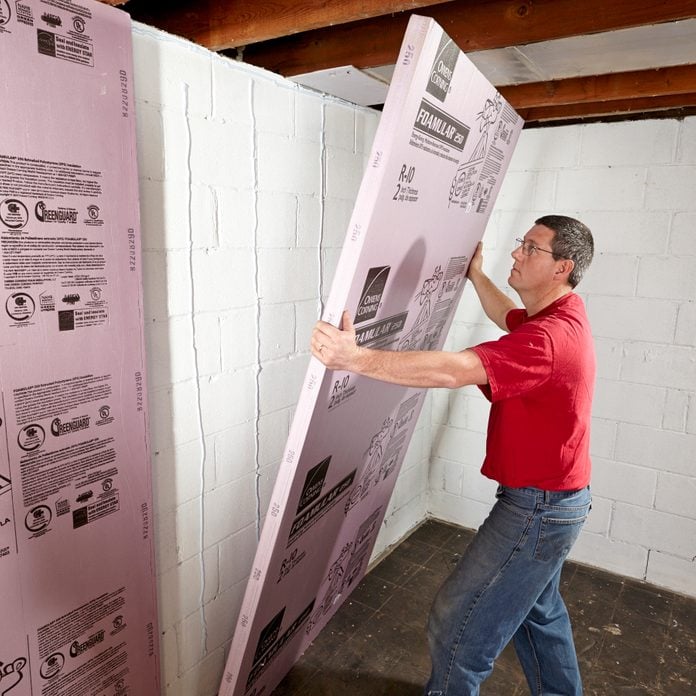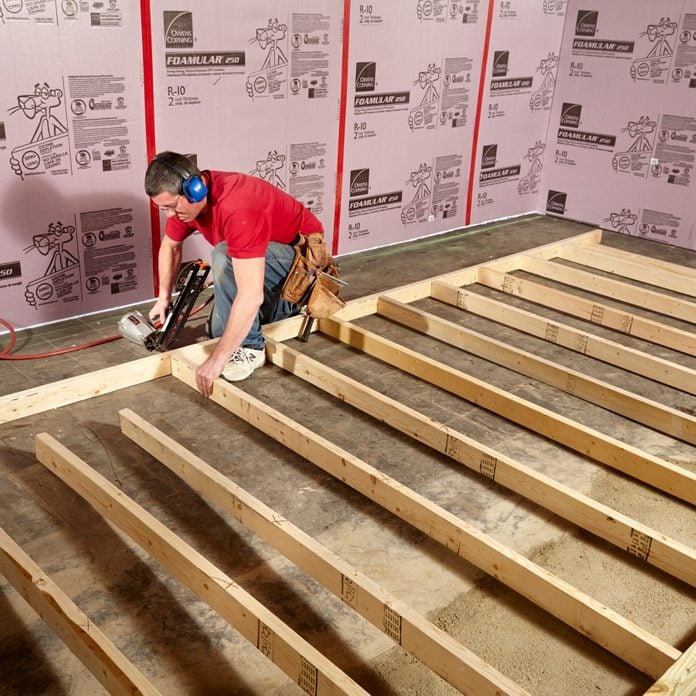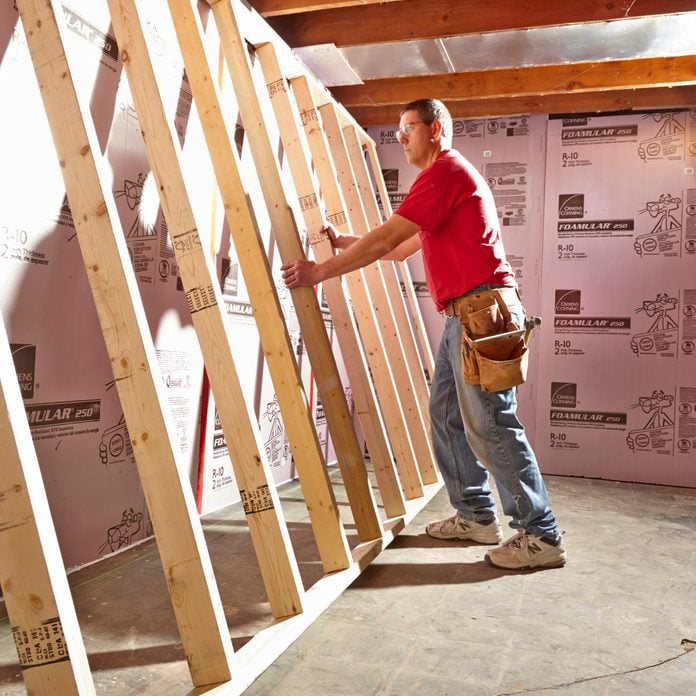what is the standard method to apply gypsum board to a concrete basement wall
How to End a Basement Wall
Adept advice for a warm, dry and inviting basement
![]() Time
Time
Multiple Days
![]() Complexity
Complexity
Intermediate
![]() Toll
Toll
$101–250
Introduction
Finishing a basement is a perfect DIY project. For a fraction of the cost of an improver, you lot can convert basement space to valuable living space. Advances in waterproofing along with new products mean your basement rooms can exist as dry and comfy as any other room in the house.
Tools Required
Materials Required
- 2x4 green treated lumber
- 2x4 lumber
- Rigid insulation
Solve All Moisture Issues First
Earlier beginning any piece of work, you must determine whether your basement has any moisture problems. If your foundation walls are merely clammy on humid summer days, fine—you're skilful to go with the methods we recommend. But if you have any problems with continuing or leaking h2o in the spring or during heavy rains, you've got some "prework" to do.
Fixes unremarkably are equally uncomplicated equally adding or repairing gutters and downspouts or adjusting the form to direct runoff water away from the house. But serious water problems may phone call for drastic measures like interior or exterior drain tiling, or exterior waterproofing, which could mean digging around the business firm or vehement upwardly role of the slab. You lot must solve all water problems, or you'll risk boxing time to come water in backside a finished wall, ruining it. You'll end up spending hundreds of bucks re-remodeling a recently finished lower level.
Simply about every carpenter or building inspector has a different opinion on how to terminate walls against masonry. The methods nosotros'll demonstrate piece of work well in about conditions, just consult with your building inspector before commencement any work to make sure y'all're meeting building codes in your surface area with these unfinished basement wall ideas.
Project step-past-stride (11)
Pace 1
Seal the Wall
- Use a paint roller to employ the masonry waterproofing product yous choose.
-
- Note: This step is only to help prevent water that naturally migrates through physical through a capillary effect.

Step 3
Install Blocking Between Joists
- Screw or nail i side of the block through the joist, and secure the other side to the sill plate.
- Pro tip: Use treated lumber if the brace will come in directly contact with bare concrete.

Step iv
Install Foam Board Sheets
- Apply the agglutinative vertically to keep water from pooling behind the foam insulation.
- Pro tip: Exist sure you utilize XPS cream insulation—other types are not as moisture resistant.

Step 5
Snap Lines on the Floor
- Snap a line on the flooring four inches away from the foam as a guide for the bottom plate.
- Note: This will leave a 1/two-inch gap between the lesser of the new wall and the foam to allow a bit of wiggle room if the foundation walls aren't perfectly plumb or straight.

Step half dozen
Get together the Walls on the Ground
- Sight every stud for a "crown" (a slight curve on the narrow side of the lath), and mark an "Ten" on the crown.
- Have all the crowns face the same direction and assemble your wall with the crowns upward.
- Note: That way, both ends of the studs are solidly on the ground when you attach the peak and lesser plates, instead of acting like rockers on a rocking chair.
- Pro tip: Build the wall so information technology tin be tipped correct upwardly. There's usually not enough room to swing the whole wall around if you don't.

Build the Walls Short
If you need to pound the walls into place with a sledgehammer, you lot've built your walls also tall. In that location's no reason that the top plate has to be tight confronting the joists—that'south what shims are for. Measure the distance from the flooring to the joists at several locations and build your wall at least 1/4 in. shorter than the shortest measurement. Trying to force a wall into place can raise the joists, which could wreak havoc with drywall joints and flooring on the rooms above.

Step 7
Tip Upwards the Walls
- Tip a wall up with the bottom plate against the wall.
- Pro tip: If the floor joists are sagging or there's ductwork in the way, you may take to elevator the tiptop of the wall in kickoff and slide the bottom plate into place.
- Pro tip: If the floor joists are sagging or there's ductwork in the fashion, you may have to lift the meridian of the wall in first and slide the lesser plate into identify as shown here.

Step 8
Fasten the Bottom Plate
- Put construction adhesive on the flooring.
- Tip the wall into place and fasten with concrete nails or screws.
- Infinite fasteners every vi feet and inside 6 inches of each end.

Step 9
Plumb the Wall and Secure the Peak Plate
- Plumb the wall most every iv anxiety.
- Pro tip: You need shims only nigh every third joist, but nail the summit plate to every joist.

Build In Place When Necessary
If your floor is horribly out of level or if you're framing around a window, information technology may be all-time to "stick frame," nailing i stud at a time instead of building the wall on the flooring.
Commencement by fastening your lesser plate, and then use a straight stud and a level to plumb up to find the location for your top plate. After yous snap a line and spike your top plate, plumb upwards again and mark the location of your first stud on both plates. Mark the balance of the stud locations on the plates using those marks. Toenail each stud into place with two nails on one side of the stud and i on the other.

Step 10
Framing Inside Corners
- Turn the terminal stud on the first wall sideways and overlap it near halfway by the connecting wall to create drywall backing.

Step eleven
Build Out Effectually Windows
- Install the wood around the window earlier you build your wall.
- Pro tip: If at that place's room, utilise foam under the boards, and tape the seams to the foam you've installed on the wall. If in that location's no room for foam, make certain to employ treated lumber, merely even so record the seams.
- Pro tip: Construction adhesive and concrete screws work all-time to attach these boards. Install the wood around the window before you build your wall.

Don't Forget Drywall Backers
It's a lot easier to add drywall backers while you still have all your framing tools out and before you fill the wall cavities. And so earlier you pack it up, walk around the unabridged work area and make sure the ceiling and all walls have a sufficient nailing surface for the drywall. The tiptop of outside corners, perpendicular intersections, and walls that run parallel to the joists are three of the most common areas where you'll demand to add backers.

Originally Published: September 22, 2020
Source: https://www.familyhandyman.com/project/how-to-finish-a-foundation-wall/
0 Response to "what is the standard method to apply gypsum board to a concrete basement wall"
Post a Comment